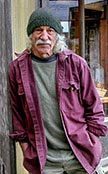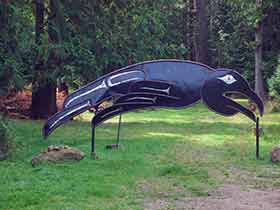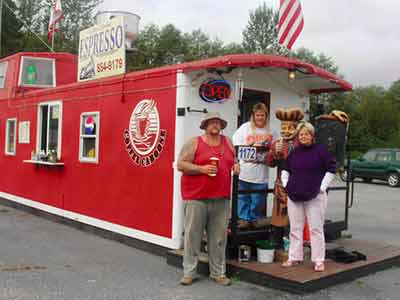I got back a week ago from a 4 week trip to Vancouver Island, British Columbia, shooting photos for a new book on builders. I was originally working on a book on North American builders in general, but when I saw the quality and uniqueness of a bunch of Canadian (and ex-patriate American) builders in and around Vancouver Island, it was obvious there was a book in this relatively small geographical area. I covered 2700 miles in my camper-rigged Toyota Tacoma 4×4 truck (a fabulous vehicle in all ways!)
I went 40 miles in an open boat up the coast from Tofino with Bruce (aka Bruno) Atkey, legendary coastal builder (and surfer). We went in Bruce’s 17’ open aluminum boat with 65hp Johnson 3-cylinder, 2-stroke, manual start outboard along with Bruce’s long-time buddy Wayne Vliet, also a builder and surfer (and musician).
We photographed cabins in the woods, a surfers’ beach shack,
Rancho Bueno
and a post and beam Indian-style long house, all made entirely of local cedar from the woods or beaches. A couple of the buildings were built entirely of split cedar, including 8’ long boards, split studs, rafters, and roof shakes. We saw bears, killer whales, and bald-headed eagles; we went surfing 3 days (hit it at 6-8’ one day!); we took a hot sauna, then jumped in the cold ocean water.
Driftwood chair by Bruce
And that was just the start.
After a week on the west coast, with its dynamic energy (the tourist hordes are less in other-than-summer months), I headed over the mountainous middle of Vancouver Island to its east side and to three islands in the Straits of Georgia, the island-filled waterway between Vancouver Island and the west coast of B. C. (more mellow territory), and had a great few weeks there.
Gate of the crow, Hornby Island, B.C.
I came home with about 1700 photos and a mountain of interviews and addresses and things to do and it’s taking me a week to just unravel it all, download and print thumbnail photos, send promised books off, order various stuff I learned about in my travels, and deal with a considerable backlog of publishing business details. Man, if I could just get through the biz stuff faster and have more time for working on books, which is why I got into publishing in the first place. Ooops, am I whining again? I have to admit to myself on occasion that maybe handling all the business crap is why I get to be an independent publisher in this increasingly run-by-committee, conglomeratized, corporate world. (I know a LOT of creative people who’d love nothing better than to create their creations and have them sell like crazy, but it just don’t work that way any more. Marketing, baby!) Onward.
Statement of Blog
I’ll post fragments and photos from the trip over the next few weeks. There are big intervals between my blogging — up to 3 weeks, so if you’re interested in what I run across in the world, check in every month or so. I really don’t know how people find the time to do daily blogs. I ain’t giving up running or surfing to blog! But at the same time I like the immediacy and world-wide-ness and non-cost-ness of it. So I’ll keep at it on this kind of schedule. I’ll keep putting up photos during the rest of October. (The photos in this posting are all from my (Olympus Stylus 800) pocket camera, and before I got into shooting the houses.) Right now I’m overwhelmed with all the material I’ve gathered, graphic and otherwise. (If anyone figures out how to painlessly clone human beings, let me know, because I could use two more of me to get stuff done and keep on exploring the world.)
Oysters on the Beach
For two nights I camped on the beach on a need-not-be-named island. In the morning I went for a run at low tide and there were oysters all over the place on the sandstone reef! (This was outside the commercial beds.) I cracked some open with rocks and had sea-infused breakfast, a la sea otter. That night I barbecued oysters over a wood fire, had potatoes and onions baked in foil, fresh-picked blackberries with cream and brown sugar for desert, and slept under a canopy looking out at the water and stars. I love this part of the world. If I’d come up here in the 70s I’d likely have stayed. People up here are a lot closer to the values of 60s-70s homesteading than are folks in Marin county, Calif., which I dearly love, but is increasingly outrageously expensive, over-regulated, and impossible for people wanting the build their own house and grow some of their own food — simple goals lots of us had in the ‘60s-’70s.
Water and Wood
In July when I got into Port Townsend (WA) on an early rainy morning and looked at the variety and number and quality of the boats in the numerous harbors, I realized this was heavy duty maritime territory. The sea is big in people’s lives here and northward. Many many people get to their homes only via boat or ferry. Boat people and sailing people have their shit together in ways not necessary for landlubbers. Carelessness can have serious repurcussions once you’re afloat. Krappy craftsmanship can mean sinking. You have to deal with real life: winds, tides, swells, currents, cold, seaworthiness, landing, fishing, sailing, and you need the concomitant skills. The people I ran into were a lot tougher than Bay Area folks. The farther north you go, the more difficult life is; winters longer and wetter; landscape more rugged; physical involvement with the forces of nature more necessary.
In addition to water being all around, and boats being so prominent in everyday life, the big thing up there is W-O-O-D. There’s wood everywhere. Trees in the forests grow like crazy. Not to minimize destructive logging practices, but there are still a fuck of a lot of trees growing in the Pacific Northwest. It’s a woodworker’s dream. There are a LOT of homes built of site-cut and milled wood; this isn’t a novelty as it is elsewhere. The beaches are lined with countless logs. In the ‘70s and ‘80s, a lot of high-quality cedar driftwood got made into homes and boats. I saw 12” wide boards 10 feet long split from cedar. Many of the homes I’m covering were built in those years, which were so vastly different from current times. Lots of builders roamed beaches, using what they found as inspiration and structure for homes and cabins. As I walked along beaches I found myself eyeballing rafter-like poles, ones I could move myself.
Lloyd House
Well, my name is Lloyd and I’ve spent 40 years shooting pictures of buildings and hanging out with builders, and my company is called Shelter, and when I meet the builder of all builders, his name is — what else — Lloyd House. Cosmic, huh?
I was introduced to his work by architect/builder Michael McNamara, who gave me a lot of guidance to builders and buildings. I’ve photographed 6 or so buildings designed and built by Lloyd, and each time it’s like coming around a corner and finding treasure. When I saw his sauna, I just let out my breath, it was so beautiful, so finely crafted, so witty. The farther I looked (and shot pix), the more I found. There were delights everywhere. A little house he built in a meadow is stunning, I’ve never seen anything like it. The owner said to me on the phone just today: “I am delighted every day of my life to be in this place.” Lloyd is the main inspiration for this book — his work, the influence he’s had on other builders, his ongoing inventiveness.
Bruce Atkey
My friend Godfrey Stephens (see below) told me I had to meet Bruce, that he was the “ultimate guy.” So he was. Boat builder, house builder, carpenter, welder, mechanic, surfer, fisherman, explorer, Bruce has built cabins, houses, lodges, and surfers’ shacks along the west coast of Vancouver Island for the last 30 years. He and his buddy Wayne have also surfed what was until recently little-known surf spots all along the island’s west coast. I shot pictures of Bruce’s creations in the woods and on the beaches, and learned a bunch of things from him about daily life in general. He was born on April 26, me on April 28 (about 15 years apart), so we have a lot in common in our Taurus tendencies, like charging headlong into life.
Godfrey Stephens
Godfrey is a third important person in the unfolding plot of this book-in-progress. I met Godfrey on a beach in Yelapa, south of Puerto Vallarta (reachable only by boat), in 1964 (see page 232 in Home Work). He was a wild young artist from Vancouver Island, painting a huge mural on the wall of the village restaurant and carving driftwood on the beach. Our paths crossed again in 1971, we weren’t in touch for 30 years, and around 3-4 years ago we started emailing each other and catching up on lives lived. It seems that everywhere I went on Vancouver Island, everyone knew him. He’d lived on beaches, built several sailboats completely of driftwood, sailed on the high seas (shipwrecked once in Mexico), once circumnavigated Vancouver Island in a 16’ catamaran, travelled to India and other exotic corners of the earth, all the time painting and drawing and carving. Check his website at https://godfreysart.com
Godfrey kept emailing me that I had to see the builders of his area and he was right. Many of the builders I photographed came directly or indirectly via him. He’s sort of my touchstone on the island. He has a wonderful bunch of friends: builders, boatbuilders, explorers, artists, craftsmen, people full of life and adventure.
“Back To The Land”
Meeting all these people in the Northwest takes me back 30 years (actually 45 years, since I started building for myself in the early ‘60s). For me it was instinctive, and necessary. The only way I was going to get a home I liked was to build it. I started working nights and weekends. And no bank mortgage — what could be better? This led me to gardening (I still have a dog-eared, mud-stained copy of Rodale’s Encyclopedia of Organic Gardening), making things for myself with my own hands. In 1965 I quit my job as an insurance broker in San Francisco, started working as a carpenter, and was thrilled. No more neckties or business lunches to endure or endless paper shuffling. I loved the smell of wood, stepping onto a floor I’d put there myself, hanging out with builders. (Same with farmers and sailors— they have to deal with real things.) Pretty soon there was what was loosely called the “back to the land movement.” It sounds a bit lame now, I guess because the media never believed it was real. But in traveling up north, I’m meeting long-lost brothers and sisters who’ve kept the faith, and the spirit. The idea in the ‘60s was the more you could do for yourself, with your own hands, the better off you’d be — aesthetically, financially, independently. Not having a mortgage (or rent) was a life-liberating experience; early on I calculated how much I was saving in not having to pay interest on a mortgage — a staggering amount. No monthly nut. Up north the onslaught of high real estate prices and attendant over-regulation haven’t dampened that enthusiasm as it has in the Bay Area. It’s wonderful to be around people that are still operating in that realm. And just about everyone I run into in my builder-oriented travels knew and loved our book Shelter (1973). Amazing to get this feedback now. It seems everyone who worked with their hands was inspired by Shelter. I love it!
It’s also caused me to reflect on just what we (builders, gardeners, crafts people) were all doing back then. We never thought we’d be “self-sufficient.” Just try growing (and processing) your own wheat to disabuse yourself of the notion of being self-sufficient. No, the idea was to do as much for yourself as possible — within limitations of having to earn a living, raise a family, etc. Building my own house saved me so much money I had the freedom to figure out what I wanted to be as I grew up. And know what? I think those principles still apply. Can you work with your hands? Then build your own house! It can still be done, the payoff (and difficulties) are more or less the same. You just can’t do it as close to urban areas as before. Or — you can do your own remodeling wherever you live. Whoops, am I preaching here?
No Direction Home
Wasn’t that show great? Bless Martin Scorsese. Who also produced my favorite rock ‘n roll film, The Last Waltz. Jon Carroll wrote a great column in the S.F. Chronicle on Sept. 30 about Dylan and Scorsese, about continuing to work and change and evolve. I went to a Dylan concert in Providence, R.I., on a hitchhiking, soul-searching trip across the US in 1965. I had my camera and the cops let me get right next to the stage. The first half was folk music. After intermission out came Robbie Robertson and Dylan rock-n-rollified. Oh yes! His bedroom window it is made out of bricks. (I came back from the trip and quit my insurance broker job.)
Bob Dylan, Robbie Robertson, Providence, RI, October, 1965
Two Great Gospel Records
When Gospel Was Gospel, by various artists, Shanachie. A great collection, including Sister Rosetta Sharp, The Soul Stirrers, and the Davis Sisters.
Remember Me, by Marion Williams, Shanachie. What a voice! Hey, isn’t black gospel music the best thing to ever come out of Christianity?
Diner for Sale in Northern Washington
I stopped for a latte at this great little diner in Cedro Woolley, Washington. It’s a caboose meticulously fitted out with a stainless steel kitchen, hardwood floors, wired and plumbed; it’s a charmer. And it’s for sale — $49,000. The owner has health problems and needs to sell it. She says it can even be moved, she thinks for about $6-7000 by truck to other parts. Want a ready-made diner? Want to start a new life? Call Jamie Sanchez, 360-854-9179.
The Coffee Caboose, for sale in northern Washington. L-r, customer, Melonie, Jamie
Inside the caboose I was talking to Jamie and her helper Melonie Lanning about the greatness of Italian cooking and they said, “Oh we love Italy, want to see our favorite apron?”
Melonie and her favorite apron
Stay Tuned — More to Come
In the next two weeks I’ll post photos of some of the buildings I photographed, and a bunch of other builders. I got really excited today looking through the thumbnails. These guys are unique!












Looking forward to the new book. Was up in Victoria running the marathon – looked for you skateboarding. There is a builder in Sedro Wooley WA if you make another trip.
>link to his work.
Hey Lloyd!
Your work IS inspiring, and sets a good example. It's a good thing for the rest of us to see an individual stay in great condition and remain flexible in mind and sprit as well. Live forever!
I'm here in Bakersfield, am 50 years old, and am about start my fifth theatre, the Jewel Box Theatre, after successfully starting the fourth, The Gaslight Melodrama, with some friends and my son-in-law. I've now produced over 40 original shows of my own since 1988 and will probably write another ten before I retire to a handbuilt house on the Big Island of Hawaii. I can only say that your work has been important to the well-being of my soul, because it proves what human beings can do if they only believe they can. Thanks for a life well-lived and shared. I'm looking forward to your next book…
David Zent
I hope you used the correct spelling for Sedro Woolley in your new book. Even the locals don't get it right!